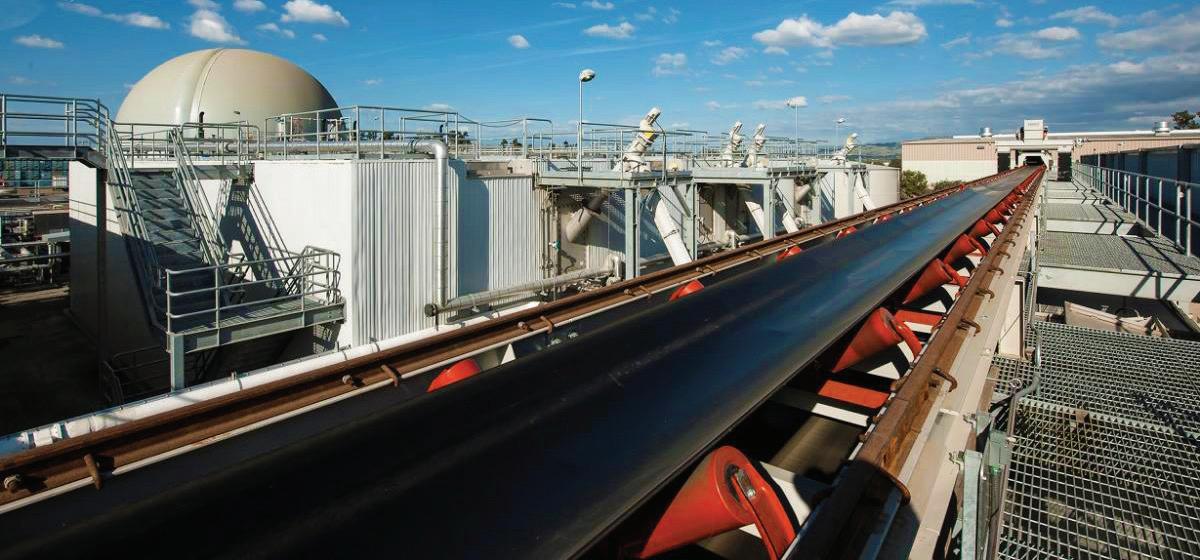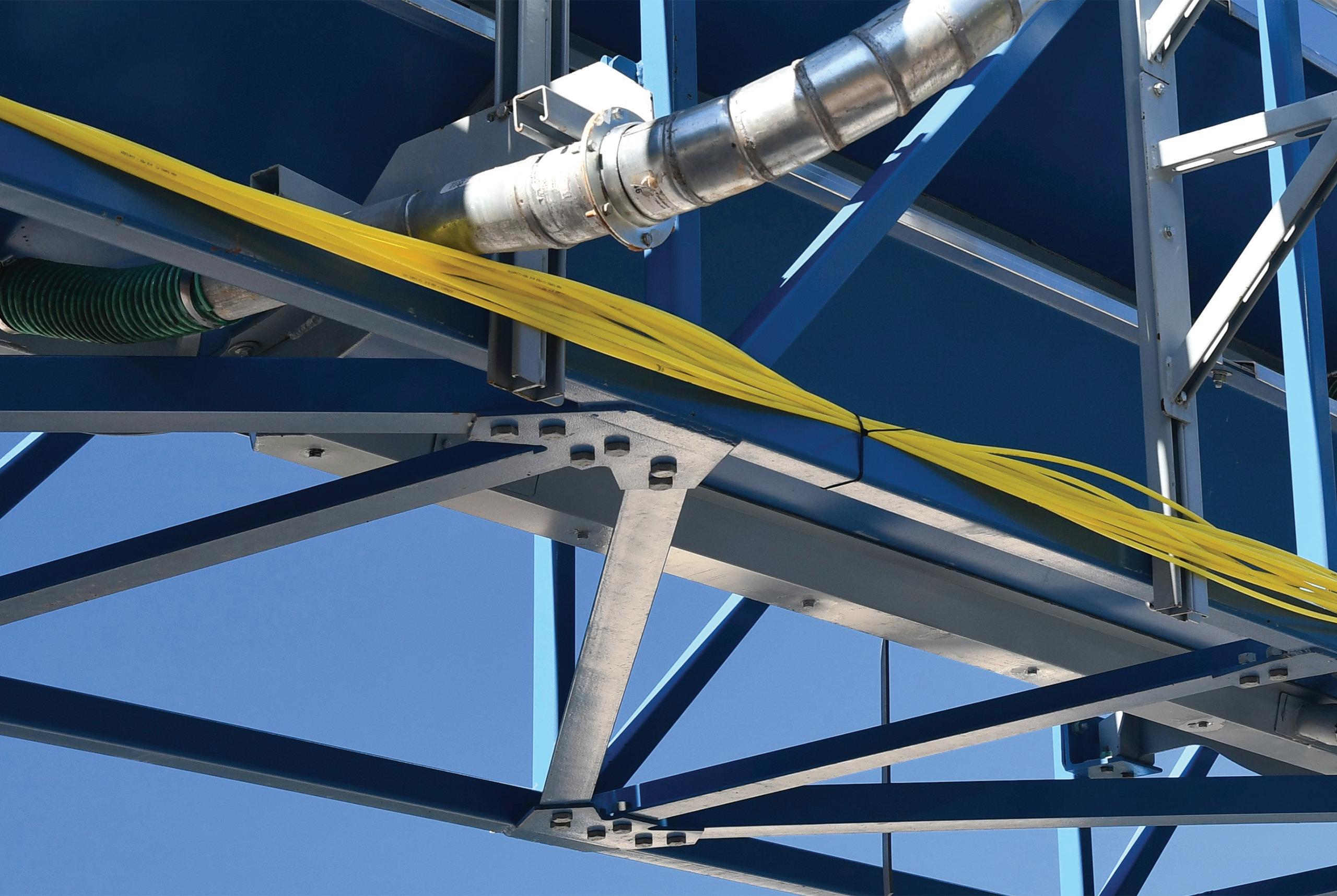
8 minute read
LOGISTICS
Chautauqua County Straw/Hay Production Capacity
Chautauqua County farmers generate limited amounts of straw used for bedding and other needs. The straw is produced from growing mostly oats, as well as barley and wheat. These farmers have land and equipment necessary for production of low-quality hay for combustion in power and heat generation plants. It is estimated that the farm-
ers can produce low-quality hay in the annual amount of 440,000 tons. This would supply fuel for power generating facilities with a capacity of 90 MW.
Farmers in the area are very interested in producing and supplying hay fuel at prices ranging from $4 to $5 per MMBtu. Most produce hay, with individual farm field crop production size ranging from 29 to 2,000 acres. Typically, two cuttings of hay are performed each year. Both round and square bales are produced by the farmers, with round
At typical straw combustion facilities, material is consumed evenly throughout the year, but storage facilities typically only accommodate three to five days’ worth of fuel. PHOTO: JOSEPH TECHNOLOGY CORP. being less costly to produce at 35 to 1,000 lbs. Square bales can range from 1,000 to 2,000 pounds.
Production capacity of hay is 3 to 4 tons per acre. Based on information provided by the farmers, the average farm gate cost of growing and harvesting hay is estimated at $52 per ton ($3.25 per MMBtu). Farmers, owning or renting the harvesting equipment, indicated that if profitable, they could produce all the hay needed. A majority is in-
STRAW FOR terested in using the ash from the combustion facility on their farms. ENERGY GENERATION Collection, Transportation and Storage Baling and transport. Baling capacity depends on the choice of
IN CHAUTAUQUA technology. The baling capacity that includes all operations connected to baling is lowest when the straw/hay is baled by a small and round baler, and it is the highest when using a big baler.
COUNTY When transporting straw/hay, various techniques and methods are used depending on the local conditions. A research project in Chautauqua County, New York, investigates the feasibility of straw/ hay-to-energy facility development. Small bales are loaded in the field by bale fork, bale loader, bale chute or bale gun. At the farm, bales are unloaded directly into the storage or an elevator or bale conveyor. Flat cars or special V-shaped vehicles are used. They will contain 75 to 250 bales. BY ISHAI OLIKER Round bales are loaded by front-end loader, loader tractor or a
Ttrencher. The same machinery is used for unloading into storage. For he technology of straw/hay production and combustransport, trucks or truck trailers are used, but also ordinary farm trailtion is well developed and has been used for many years ers or specially designed vehicles. Usually, the tractor is only towing one in Scandinavian countries, particularly in Denmark, trailer, and it will contain from 8 to 14 bales. where there are more than 8,000 small and large straw- Medium-sized bales are loaded and unloaded by front-end loader, fired heating plants collectively consuming more than 1.5 mil- trencher or a loader tractor. The front-end loader is the most used lion tons of straw. machine for both loading in the field and for unloading in the storage.
A study was conducted to investigate the opportunity to The size of the loads varies 12 to 45 bales, but most often load will be create a reliable and cost-effective source of straw and hay fuels 24 bales. for heat and power generation at a farm in Chautauqua County, Big bales are loaded and unloaded by front-end loader, trencher, New York. The following is an excerpt from a detailed report loader tractor or a telescope loader, which is suitable for unloading available upon request. because it can reach high up when storing in stacks. The front-end
loader is the most widely used. Capacity is highest when handling two bales at a time. The size of the load varies from 6 to 18 bales. Over long distances, the tractor is often towing two trailers so that the size of the truckload attains 24 bales per trailer per trip. By handling big bales, the manpower required is about 13 minutes per ton.
Storage. In July and August, the straw/hay is harvested and collected. At the combustion facility, it is consumed evenly throughout the year, but due to the lack of storage facilities (typically only for three to five days), large power stations are not able to receive it until immediately before firing. Intermediate storage is typically provided at the farmers’ facilities. The supplier is paid for storing the bales at his own facility. Typically, payments for this service amount to 1% a month.
Delivery to plant. The straw/hay must be delivered to the plant in accordance with a crop delivery contract. It may be a direct agreement with the farmer, an association of crop producers, or a contractor. This agreement includes delivery dates, quantities to be supplied, contracted prices and quality criteria. Typically, a farmer transport, either a tractor or a truck, is used. The farmer loads and transports the crop to the plant, and the plant personnel unload it either by forklift truck or an overhead traveling crane. When transporting by haulage contractor, the farmer or the haulage contractor loads the track, and the haulage contractor travels to the plant. There, plant personnel unload the bales by forklift track. In transporting by tractor, the speed is considerably lower than by haulage contractor, and consequently, capacity is lower. The manpower requirement increases, and the capacity decreases with increased transport distance. The manpower required is greater and the capacity lower when transporting by tractor than by haulage contractor, and these differences increase with increasing transport distance.
When transporting by truck, there are almost always 12 bales loaded on the track and 12 bales on the track trailer distributed in two layers. This is also typical for tractor transport, but load sizes of 16 or 20 bales are typically used, particularly for transport over short distances. Plants unloading by crane require that the bales are arranged accurately on the vehicles, have a specified dimension and do not exceed a certain weight. Crop price. Trading in crop for energy purposes among producers and the energy sector are determined by delivery contracts for several years, between the individual crop producer or an association of producers and the purchaser. The price is expressed in dollars per ton of delivered hay. The purchasers of fuel enter into long-term crop delivery contracts to ensure that they can supply heat and energy to the consumers. Not all fuel is traded according to crop delivery contracts, as plants may often obtain a better price for part of their annual consumption by spot market purchasing.
The producer's fuel price includes the return on investment and depreciation on the machinery, wages and cost of fuel in connection with growing, baling, and gathering, and costs of storage and transport to the generating plant. Additional costs include insurance and the producer’s risk covering, i.e., due to shrinkage caused by bad weather conditions during the period of harvest and shrinkage during storage.
Feasibility Analysis in Chautauqua County
Four optimum site locations for the potential straw/hay-fired plants in Chautauqua County have been selected as: 3 MWe (megawatts electric) CHP facility located at the Airport Hill Industrial Park; two 2 MWt (megawatts thermal) district heating plants located at the BOCES New York Educational Centers—LoGuidice in Fredonia and Hewes in Ashville; and a 4 MWt district heating plant located at Jamestown Community College.
Each of the aforementioned sites has been investigated and analysis of electric and thermal loads performed. Based on this analysis, the optimum size of the hay-fired plant has been selected.
The preliminary feasibility analysis for the 3 MWe Airport Hill CHP plant indicated that the power production cost is $65 per megawatt-hour. This cost is comparable with the energy cost produced by gas turbine installations at current gas prices.
The economic analysis of the straw/hay-fired district heating plants located at BOCES and JCC provide potential savings resulting in payback periods between 8 and 13 years, which are quite long. The implementation of these projects will require state and federal green power subsidies. Further escalation of fossil fuel prices will increase the economic feasibility of the hay-fired plants.
Potential benefits for Chautauqua County include 90 MW of potential straw/hay-fired capacity; 600 million kilowatt hours/year, generating $39 million annually; and creation of over 2,250 jobs.
Conclusion
It is recommended to proceed with the development of the proposed straw/hay-fired plants in Chautauqua County. To facilitate the implementation of the proposed projects, it is recommended to apply for cost-sharing grants to NYSERDA, the U.S. DOE and USDA.
This study was sponsored by the New York State Energy Research and Development Authority and the Chautauqua County Industrial Development Agency.
Author: Ishai Oliker President, Joseph Technology Corp. 201-573-0529 jtcincorp@optonline.net
Figure 1. U.S. Softwood Lumber Price Index, 2019- ‘20
Producer Price Inde x, Softw ood Lumber (1982=100)
320
300
280
260
240
220
200 Jan. 2019 Feb. 2019 Mar. 2019 Apr. 2019 May 2019 June 2019 July 2019 Aug. 2019 Sept. 2019 Oct. 2019 Nov. 2019 Dec. 2019 Jan. 2020 Feb. 2020 Mar. 2020 Apr. 2020 May 2020 June 2020 July 2020 Aug. 2020
U.S. SOUTH CENTRAL FIBER PRICES: A Q3 SNAPSHOT
BY ANDREW COPLEY
Managers battled multiple issues in Q3 2020, including fires, hurricanes, COVID and market volatility. While lumber production surged, generating more residual volumes into fiber markets, demand from the pulp and paper sector continued to struggle with the impacts of the coronavirus on end-market products. The pandemic deteriorated market conditions for printing and writing paper while accelerating newsprint’s decline. In the woods, the combustible mix of hot weather, strong winds and low humidity fueled explosive fires. Hurricane Laura added to the volatility, snapping 30 million tons of pine and 9 million tons of hardwood in Louisiana alone, comprising more wood than in-state mills consume in a typical year.
At the end of Q1 2020, uncertainty surrounding coronavirus impacts on lumber markets led to mill curtailments and a drawdown of inventory. Although housing slowed, it bounced back and became a bright spot for this year; housing starts for the three months ending in August were up 10% year-overyear. The uptick in housing, as well as repair and remodeling, increased lumber demand while supply chains were depleted, pushing lumber prices to record levels. According to the Producer Price Index (PPI), softwood lumber prices have risen 47% since April 2020, the highest four-month increase since data collection began in the 1940s (Figure 1). In August alone, prices rose 16% from the previous month, the highest monthly increase on record.







